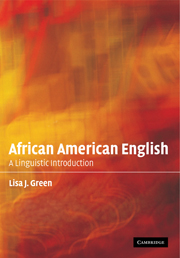Book contents
- Frontmatter
- Contents
- Foreword by John R. Rickford
- Preface
- Introduction
- 1 Lexicons and meaning
- 2 Syntax part 1: verbal markers in AAE
- 3 Syntax part 2: syntactic and morphosyntactic properties in AAE
- 4 Phonology of AAE
- 5 Speech events and rules of interaction in AAE
- 6 AAE in literature
- 7 AAE in the media
- 8 Approaches, attitudes and education
- Endnotes
- References
- Acknowledgments
- Index
3 - Syntax part 2: syntactic and morphosyntactic properties in AAE
Published online by Cambridge University Press: 05 June 2012
- Frontmatter
- Contents
- Foreword by John R. Rickford
- Preface
- Introduction
- 1 Lexicons and meaning
- 2 Syntax part 1: verbal markers in AAE
- 3 Syntax part 2: syntactic and morphosyntactic properties in AAE
- 4 Phonology of AAE
- 5 Speech events and rules of interaction in AAE
- 6 AAE in literature
- 7 AAE in the media
- 8 Approaches, attitudes and education
- Endnotes
- References
- Acknowledgments
- Index
Summary
Focal point For the most part, words in sentences in AAE are arranged in the same order as words in sentences in other varieties of English, but in AAE different combinations are allowed. For example, in AAE, the word order subject-auxiliary-main verb-object occurs in AAE I didn't see nothing just as in general American English I didn't see anything. The difference is that in AAE both the auxiliary and object can be negative. Also, AAE uses the same words that occur in other varieties of English, but these words can take on different meanings and functions. One case in point is that it can be used to indicate that something exists: It be just the right amount of decoration on those birthday cakes.
When I rose this morning, I didn't have no doubt.
[line from a song sung in African American church services]Introduction
This chapter presents a description of patterns in the syntactic and morphological components of AAE. As in chapter 2, I will be concerned with the way words are combined to form sentences, and I will also consider morphology, that part of the system that deals with the function of smaller units of words such as suffixes. Oftentimes negative opinions are formed about AAE and the people who speak it based on the type of data that will be discussed in this chapter.
- Type
- Chapter
- Information
- African American EnglishA Linguistic Introduction, pp. 76 - 105Publisher: Cambridge University PressPrint publication year: 2002



